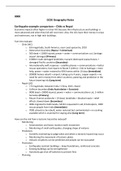0000
GCSE Geography Notes
Earthquake example comparison – Chile vs Nepal
Economic impacts often higher in richer HIC because the infrastructure and buildings is
more advanced and when they fall will cost more. Also, the LICs have their money in crops
and mattresses, not in high tech buildings.
Fact into evaluate
- Chile (HIC)
o 8.8 magnitude, South America, near coast epicentre, 2010
o Destructive boundary (Nazca + S American)
o 500 dead + 12000 injured, power + water + communications cut, Santiago
airport damaged (Primary)
o 1500km roads damaged landslides, tsunami destroyed coastal towns +
damaged Pacific countries (Secondary)
o Internationally swift response – satellite phones = communications = better
rescue operations, fast repairs to Route 5 (24hrs) = link to Santiago = more
help, power + water restored to 90% homes within 10 days (Immediate)
o 200000 homes rebuilt + airport, taking up to 4 years, copper exports = no
need for aid in money from other countries, planning and prediction in the
future lowering risk (Long term)
- Nepal (LIC)
o 7.9 magnitude, between India + China, 2015, inland
o Collision boundary (Indo Australasian + Eurasian)
o 9000 dead + 20000 injured, power + water + communications cut, 3 million
homeless (Primary)
o Mount Everest avalanche = 19 dead, landslides = blocked roads = relief
effects slowed down (Secondary)
o 300k migrated to Kathmandu, $415m requested in aid, 8 helicopters, 1000
rescue people from India (Immediate)
o 7000 schools to be rebuilt, water restored but contaminated = no cooking
available which is essential for staying alive (Long term)
How can the risk from a tectonic hazard be reduced?
- Monitoring
o Seismometers and lasers monitor earth movement
o Monitoring of small earthquakes, changing shape of volcano
- Prediction:
o Scientific monitoring to judge when and where a tectonic hazard may occur
o Monitoring the movement of tectonic plates
o Volcanic eruptions can be predicted and people can be evacuated
- Protection:
o Earthquake resistant buildings – deep foundations, reinforced concrete
o Existing buildings can be strengthened
o Automatic gas shut off switches to prevent fires
- Planning
, o Identify hazardous areas and not develop as much there
o Emergency services(blankets, water, food) can be stockpiled
o People trained to know what to do in the case of an tectonic hazard
o Governments can plan evacuation routes
Why might one live in a hazardous area?
- Tectonic hazards don’t occur often
- Poverty doesn’t allow for a family to move
- Earthquake resistant buildings
- Some people may not even know they are on a plate margin
- Earthquakes may brig water to the surface in desert regions
Tropical Storm example – Typhoon Haiyan
- Effects:
o 6300 killed, over 600000 displaced (Primary)
o Power supplies cut for a month, 6 million lost their source of income (2ndary)
- Responses:
o UK shelter kits, international government food, water, shelter (Immediate)
o Rebuilding of roads, bridges, airports. Rice farming and fishing re-established
Climate change
Evidence
- Using ocean sediments from quaternary period to show cooling = climate change
Causes - Natural
- Orbital changes:
o Milankovich cycles – tilt of Earth, orbit more elliptical (100k yrs)
- Solar activity:
o Sunspots – dark patch on sun (11yr cycle) = more heat
- Volcanic activity:
o Volcanic ash blocks out sun
o Droplets from SO2→H2SO4 = reflecting radiation from Sun
Causes – Human
- Fossil fuels:
o Burning = carbon dioxide
- Agriculture:
o Fertiliser = nitrous oxide (300x more heat absorbed)
o Rice farming + livestock = Methane
- Deforestation:
o Burning of wood = carbon dioxide
Management:
- Mitigation
o Using renewable energy such as wind = less carbon
o Carbon capture – carbon captured from fossil fuel plants and injected as a
liquid into the ground
, o Planting trees
o International agreements such as Kyoto Protocol – countries reduce
emissions by 5%
- Adaptation
o Drought resistant crops, new irrigation systems
o Using glaciers ‘melting’ to use as water
o Sea walls, houses built on stilts
Coastal Landscapes
Waves
- Formed by wind transferring energy to the surface of the sea
1. Circular orbit in open water
2. Wavelength gets shorter
3. Friction with the seabed distorts the circular motion
4. Top of the wave moves faster
5. Increasing elliptical orbit
6. Wave begins to break due to differences in speed
7. Swash (water up the beach)
8. Backwash (water down the beach)
- Constructive : low, long wavelength, strong swash, net beach sediment gain, gentle
slope
- Destructive : opposite
Types of Weathering:
- Biological: Plants and vegetation = roots = cracks, animals (eg rabbit) burrows into
weak rocks
- Mechanical (forces) : The disintegration of rocks = scree
- Chemical (reactions) : acid rain on limestone
Mass Movement:
- Landslide: Blocks of rock slide down a slope due to rain infiltrating rock = heavy = fall
- Rockfall: Freeze thaw = rock fragments break away from cliff = scree
- Slumping: Saturated soil and weak rock slump along a curved slip plane
- Mudflow: Saturated soil and weak rock flows down a slope = lobe at bottom
Erosion:
- Hydraulic power: Waves → cliff cracks = air compression (cavitation) = explosive
force = more cracking
- Abrasion: Sand + pebbles → cliff = friction (sandblasting) = wear down = smooth cliff
o Corrasion: rocks → cliff = jagged edges on cliff
- Attrition: Rocks in sea collide = round pebbles
Transportation




